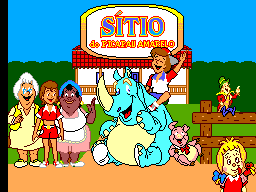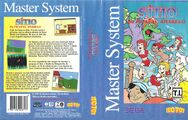Difference between revisions of "Sítio do Picapau Amarelo"
From Sega Retro
(→Items) |
|||
| Line 31: | Line 31: | ||
* Pássaros engaiolados (caged birds) | * Pássaros engaiolados (caged birds) | ||
* Gota de sangue do morcego gigante | * Gota de sangue do morcego gigante | ||
| − | * 6 aranhas pequenas | + | * 6 aranhas pequenas (6 small spiders) |
| − | * Carapuça do Saci | + | * Carapuça do Saci (Saci's carapuça) |
| − | * Bastão de japecanga do Curupira | + | * Bastão de japecanga do Curupira (Curupira's japecanga stick) |
| − | * Fio de cabelo da Iara | + | * Fio de cabelo da Iara (Iara's strand of hair) |
| − | * Lágrima da Cuca | + | * Lágrima da Cuca (Cuca's tear) |
===Enemies=== | ===Enemies=== | ||
Revision as of 16:56, 6 July 2017
This teeny-tiny article needs some work. You can help us by expanding it.
| Sítio do Picapau Amarelo | ||||||||||
|---|---|---|---|---|---|---|---|---|---|---|
| System(s): Sega Master System | ||||||||||
| Publisher: Tectoy | ||||||||||
| Developer: Tectoy | ||||||||||
| Genre: Action | ||||||||||
| Number of players: 1-2 (alternating) | ||||||||||
| ||||||||||
Sítio do Picapau Amarelo is a platform game developed and published by Tectoy for the Sega Master System, released exclusively in Brazil. The game is based on the Brazilian novel series of the same name, which is commonly considered equivalent to "The Wonderful Wizard of Oz"' series for the Brazilian audience.
Tectoy bet on the popularity of the series hoping to catch more attention of the infantile audience, similar to what they had previously done with Mônica no Castelo do Dragão and its "sequels", although their plan wasn't successful this time, mainly because it was released when the console was in a big decline, losing market to several other consoles.
Contents
Gameplay
In Sítio do Picapau Amarelo you control either Pedrinho or Emília and two players can play alternating, although they have to share the controller connected to port 1. It's a very simple platform game on which ![]() attacks and
attacks and ![]() jumps; pressing
jumps; pressing ![]() or
or ![]() twice, then holding it, causes the character to run.
twice, then holding it, causes the character to run.
Some enemies cannot be damaged, like marimbondos (wasps), while others can be damaged by jumping on top of them, like in a typical Master System platform game. Curiously the second stage is completely different depending on the character chosen.
Items
- Ninho com ovos (nest with eggs)
- Vidas extras (extra life)
- Pássaros engaiolados (caged birds)
- Gota de sangue do morcego gigante
- 6 aranhas pequenas (6 small spiders)
- Carapuça do Saci (Saci's carapuça)
- Bastão de japecanga do Curupira (Curupira's japecanga stick)
- Fio de cabelo da Iara (Iara's strand of hair)
- Lágrima da Cuca (Cuca's tear)
Enemies
- Morcego
- Marimbondo
- Redemoinho
- Cobra
- Aranha
- Piranha
- Armadilha de caçador
- Gavião
- Onça
- Macaco
- Madeireiro
- Caçador
Stages
- Stage 1 - Sangue de morcego
- Stage 2 - Carapuça do Saci
- Stage 3 - Bastão de salsaparrilha do Curupira
- Stage 4 - Fio de cabelo da Iara / Lágrima da Cuca
Production credits
- Storyline by: Edson Takeshi Nakaya, Lobato Family
- Game Design: Edson Takeshi Nakaya
- Coordinator and Programming Manager: Heriberto Manrique
- Programmers: Elielson Salaro, Luis Carlos Ferreira
- Marketing Manager/New Business Development: Vivien Navarro
- Graphic Designers: Daniel Trevisan, Edson Takeshi Nakaya, Melissa Lotfi Hollo
- Group Manager/Videogames Marketing: Andrea Bedricovetchi
- Product Manager: Paulo Montini
- Product Assistant: Denise Ortiz Miotto
- Music and Sound Effects: Silvio Mario B. Depieri
- Special Thanks to: Duda "Lobatologa" Mattos, Joyce Lobato and Jorge Kornbluh, Alvaro Gomes
Physical scans
References


